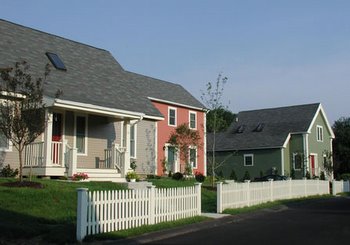| factory-built homes |
 Photo courtesy of ULI Development Case Studies. | Manufacturers
of all types of factory-built homes use standardized designs and
components to lower the cost of the production process and achieve economies of scale
by purchasing building materials in bulk quantities. Because production
is done primarily in a factory, rather than on-site, the construction
and delivery of homes is also unlikely to be subject to costly delays
caused by adverse weather and other environmental conditions. The cost savings that can be achieved through these techniques are substantial: in 2008, the average sales price of a new, average-sized manufactured home was $64,900, or $41.34 per square foot, while a new single-family site-built home of average size (excluding land) cost $217,744, or $88.55 per square foot - more than twice as much on a per square foot basis. [1] |
Addressing community concerns: Objections to factory-built homes are often related to their appearance and safety, particularly in areas prone to tornados, hurricanes, and other severe weather. In general, these concerns are based on outmoded images and stereotypes of single-wide mobile homes, "trailer parks" and their occupants, and the effects they have on nearby property values and quality of life. Since the mid-1970s, however, all manufactured homes have been built in compliance with a HUD code (The Federal Manufactured Home Construction and Safety Standards) that ensures basic standards of safety and soundness in construction. Prior to installation, homes must be checked by a certified inspector, who verifies that they meet national requirements for durability, fire resistance and quality. The HUD code does not apply to modular homes, which must meet state and local building codes in the communities where they are installed. Design-related concerns are also outdated; modern manufactured homes can easily blend into most urban and suburban neighborhoods, and modular homes are almost always two or more stories tall and incorporate design features that make them virtually indistinguishable from conventional single-family homes. In most cases the quality of construction is superior to on-site construction due to more precise construction standards at the factories.
| Obstacles to development:
A number of states have passed legislation that prohibits local
jurisdictions from discriminating against manufactured homes when
developing and implementing zoning policies (Click here to visit the Manufactured Housing Institute to learn more about statutes in your state). Even so, one report notes that "when a manufactured home buyer seeks a lot to buy or a new land lease community to move into, they often find difficult, expensive and time consuming land use regulations barring their way." [2] These regulations include:
Manufactured homeowners can create a more stable living situation through cooperatively taking ownership of the underlying land with other homeowners in their community. This mechanism is known as a Resident-Owned Community (ROC). Click here to learn more about the ROC. |
| Click
on the links below to learn more about other types of housing that can
help communities meet the needs of households with a range of
preferences and budgets: Multifamily/attached homes, which may include apartment buildings, condominiums, town homes, row houses and duplexes. "Factory-built" homes, from manufactured homes built entirely in production facilities to modular housing that is assembled on-site. Accessory dwelling units within or attached to a larger single-family home, or on the same lot. Mixed-use housing, where residential units co-exist with commercial and retail enterprises. Single-room occupancies, also called efficiency apartments and residential studio units. |
| You are currently reading: Revise zoning policies to allow development of a range of housing types "as of right" Greater housing diversity and affordability may be achieved by revising zoning policies to eliminate both direct and "back door" prohibitions and explicitly allow a range of housing types, rather than requiring a special review process or disallowing certain types of structures entirely. Other pages in this section:  Consider other innovative land use regulations that facilitate delivery of lower-cost homes Consider other innovative land use regulations that facilitate delivery of lower-cost homes Local officials can implement an array of land use tools to create a regulatory environment that is hospitable to the development of homes affordable to working families. Click here to view other resources on zoning policies that allow housing diversity. |